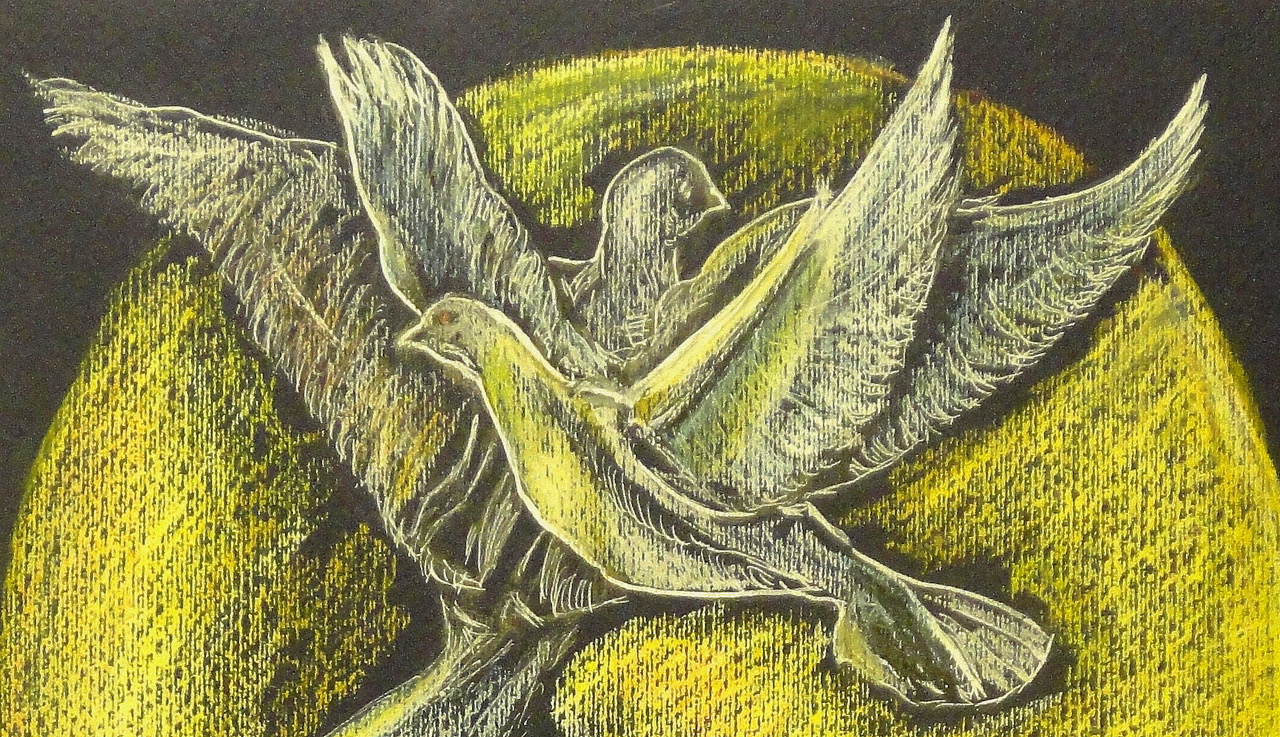STORIES BEHIND ARTWORKS
Published in The Times of Israel – https://blogs.timesofisrael.com/on-the-wings-of-love-new-exhibition-of-jewish-art-in-lithuania/
Highlights for Shtetl Songs exhibition in Lithuania
Elie Wiesel, Leonard Cohen, Lev Dodin and Marian Turski as friendly inspirations for art of Michael Rogatchi
Commemorating Art in a Restored Place
There is nothing more natural and more humane than to restore the places in which life was broken, and to keep our living remembrance there.
This is the case with a historical large brick synagogue that was built in the early 20th century in Alytus, Lithuania, and that has been abandoned for many years after WWII, being used sometimes as a salt deposit. Then, a century after it was built, the impressive and important building has been fully restored. The restoration took over five years and a substantial budget. Since 2021, the restored synagogue has hosted the Audiovisual Arts Centre that produces and hosts many concerts and exhibitions.
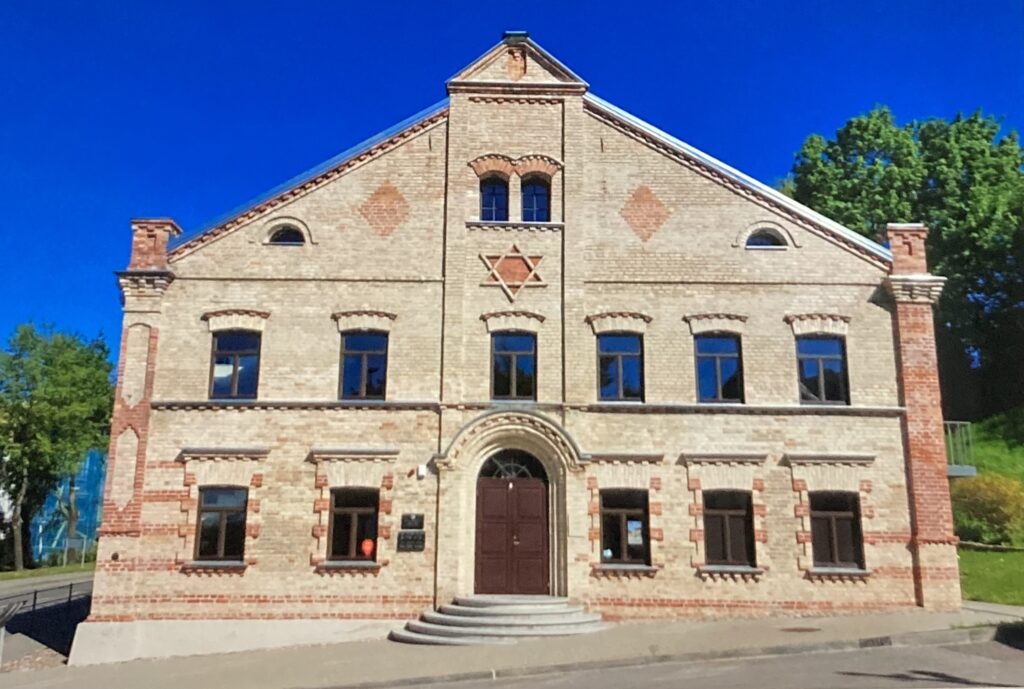
Michael and mine dual Shtetl Songs exhibition has been invited there for a month-long show in September – October 2025, as part of the European Days of Jewish Culture that are unfolding for two months this year, from September 7th through November 4th, under the People of the Book theme.
We found it gratifying to be able to show our both artworks dedicated to the memory of the people from different generations, whose lives had been interrupted most dramatically and tragically, at an attentively restored historical synagogue. It makes all the sense to the effort, and it places it in the right, humane context.
Via this collection and this exhibition, we are also paying homage to our both families which in a whole or partially are from Lithuania.
The collection was analysed in a special critical essay by a well-known historian of religions Dr Michael de Saint-Cheron. In our insights, we would like to tell about some meaningful connections, stories and people behind some of the works.
Stories and people behind artworks
Some works from our 25-strong collection have or refer to special stories and to the great people, too, importantly. And it is often the case with this kind of art, when an artist looks into his personal or our common memory as the source for new creations. From our own experience, we know that this strive can bring very encouraging and meaningful surprises.
When, many years ago, Michael was asked by the leadership of the Vilnius Public Jewish Library, to create an oil painting whose purpose would be to be just one oil painting work in the library premises, as a special art focus point, Michael thought about our dear friend Elie Wiesel and his world which via his great books has become known and had awaken conscience among millions people world-wide.
Working on that piece, Michael decided that the boy whom he called Yiddishe Son, and who was a young Elie, should play a violin.
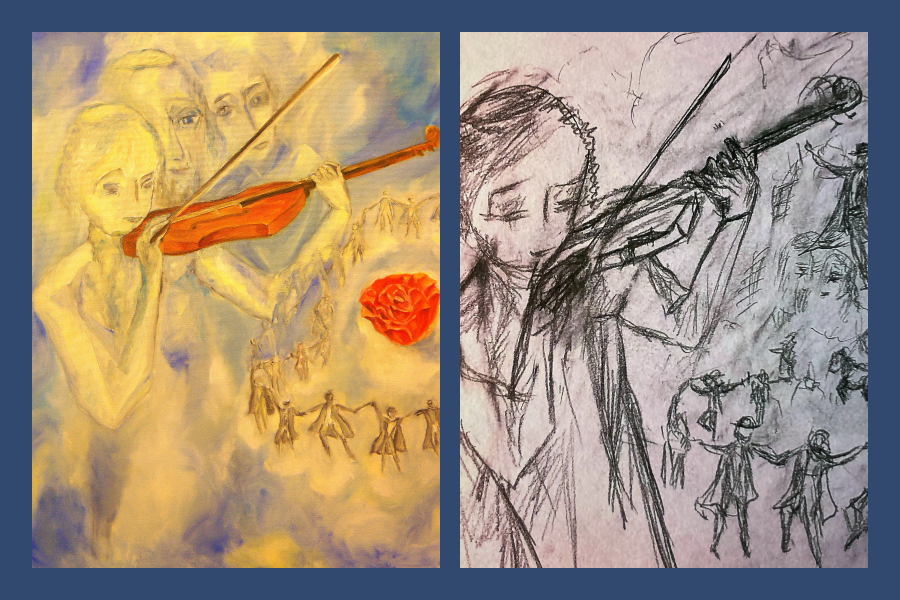
When Elie Wiesel saw the painting, he was deeply moved and asked Michael how did he know his story with the violin? We did not, at the time. So, a great writer told us a heart-rending story about the boy who loved to play his violin and did it exceptionally well. The boy himself, his family in Siget, Romania, and all their friends were positive that when the boy will grow up, he will become a performing violinist.
Then the Shoah happened, and on the Shavuot in 1944, the boy and his entire family were seized and deported in a cattle-wagon to Auschwitz, where his young sister was burned alive on the night of their arrival in front of all of them. His mother was viciously murdered very soon after that.
The father and the boy were left in the Auschwitz barrack, with the boy’s violin as their only treasure, which was enormously important for both of them as their only reminder of the connection to their life and family before the nightmare of the Shoah.
The boy’s father tried very hard to manage somehow that his teenage son would survive. He heard that those who were accepted to the Auschwitz inmates’ orchestras, there were two for male musicians, and one for females, do have a better chance to survive.
The boy who was shocked to his core by the vicious murder of his sister and mother, and who saw everything that was going around him and his sick father in the death camp, was very far from the tiniest thought of playing, as Elie has told us decades on.
His father, who was extremely worried for him, begged him to try. Purely out of his respect and passion towards his suffering father, young Elie agreed and one early morning, he took his beloved violin and tried to rehearse something. It did not last long though. In a minute, the barrack’s guard, who was not German, jumped towards the boy, grabbed his violin, and smashed it in front of his and his father’s eyes. Just like they murdered his sister.
Never again the great Elie Wiesel who was a very good and promising violinist, could take a violin in his hand. “I just could not”, he said to us , with that look in his eyes. – “ But how on earth did you know, Michael, that a violin was a part of my heart, always?” – “ I did not”, – replied Michael who was deeply affected by the story which Wiesel did not tell often, in the same way in which he never spoke publicly about the murder of his young sister, because both nightmares were acutely painful to him till the rest of his life, – “ I just felt that you must be loving a violin, as much as I do. I did not know that you were playing it yourself” – said Michael. “ Well, it seems to me , you knew, somehow”, – smiled Elie Wiesel quietly.
And now on, this Yiddishe Son, Elie Wiesel, does play his violin in Michael’s painting, and he will do it forever, as real Elie in real life always loved to do but was brutally and knowingly deprived of it.
This is what the power of art can be, bringing incredible discoveries sometimes. The original oil work, dedicated to the great writer and dear friend of ours, was on a long-term loan to the Vilnius Public Jewish Library for 15 years. It is part of Michael’s Daily Miracles collection depicting Jewish heritage. And at the current exhibition in Alytus, one can see Michael’s study for it, which is part of our special Shtetl Songs collection.
Another of Michael’s works on display is his study for his famous Zion Waltz, dedicated to our great friend and gentle mentor Leonard Cohen.
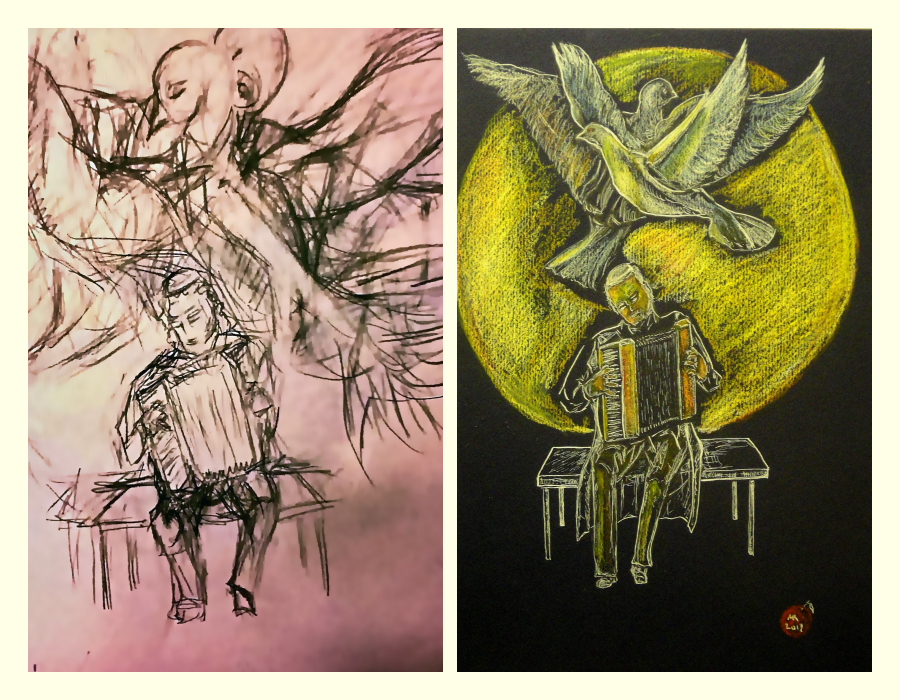
Michael created his first Zion Waltz in 2013 as part of his well-known and widely exhibited Jewish Melody series, whose international inauguration was part of IV World Litvak Forum in Vilnius. Soon after, Michael created a special, enlarged version of the work and we sent it to Los-Angeles to Leonard, who appreciated Michael’s art highly, and who always mentioned it in his letters to us.
Upon receiving the work, which conveniently arrived just days before Leonard’s 79th birthday, he sent us his usually cordial, but in this case, truly special message: “ Michael, at my age, I am busy with giving my things to people. But not this one. Not this.” We treasure this reaction and the attitude of the great man whom we were so privileged to be friendly with for years, ever since.
The other famous work from Michael’s Jewish Melody series is known in several versions, which are at the prestigious collections in Israel, the USA and France, is the title-work of the series. At the exhibition, one can see the study for the special version of the work, made in 2017.
The work is dedicated to Michael and Inna’s close friend and long-time colleague, outstanding theatrical director Lev Dodin. Since the moment when Michael presented his specially created for the giant of the world theatrical stage artwork, Lev Dodin has placed it just next to him in his study where he spends the most of his time. To the best of our knowledge, the work is still there.
And at the exhibition, people would be able to see Michael’s study for this particular version of his Jewish Melody. It is Flight – as Dodin’s world of mighty emotions, deep humanity, and never-failed devotion to his people.
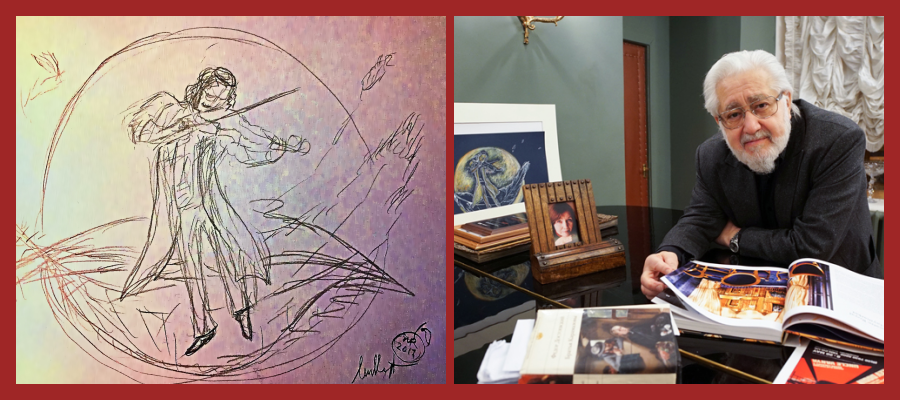
At the exhibition in Alytus, there is also Michael’s work depicting his artistic interpretation of Psalm 1, part of his ongoing Psalms Country series. As it happened, this work , in its variations, resonated with many very different people, with different backgrounds and professions, physicians, writers, diplomats, musicians, philosophers in different countries, including Finland, Austria, France, US, and Poland. And in Poland, the case is special , deep and highly important for us.
For years and decades, we were close friends and colleagues of an outstanding man, historian Marian Turski, the Holocaust survivor in Poland, who was the leader of the process of active remembrance not only in Poland, but in Europe and beyond.
Marian was leading the famous, and essentially important in documenting the Shoah the Historical Jewish Institute in Warsaw, he was chairman of the Association of the Prisoners of the Concentration Camps, he led the International Auschwitz Committee for decades, and he was the chairman of the board of the POLIN, the Museum of History of Polish Jews, from the inception of the Museum’s idea until Marian’s passing in February this year.
Refined intellectual, bright writer, deep historian, deep, thoughtful and very knowledgeable man, Marian loved Michael’s art. “ I admire Michael’s works, and am always very fond of them. I am deeply engaged also in Michael’s artistic variety and so many different ways in which he expresses his ideas” – Marian wrote to us on one of so many occasions during many years of this most stimulating friendship.
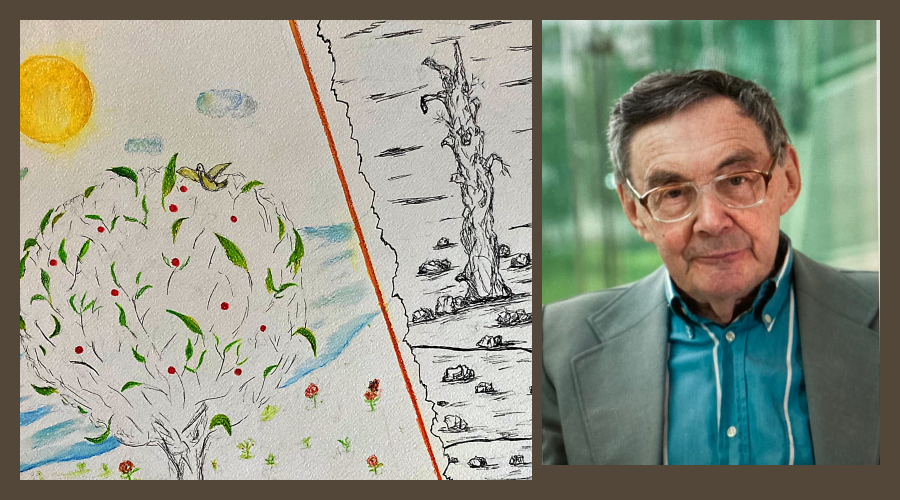
This very work, Psalm 1 – 3 ( 2023) was the last artwork which we sent to our dear friend Marian last autumn ( 2024), just a few months before his passing in February this year. The work now is with Marian’s family in Warsaw, and we both are very glad about it, and also about the fact that the work which he valued so highly and liked so much and which did speak to him, did reach him in time, that he saw it and enjoyed it. It does matter to us a lot.
Today, the initial version of this work can be seen by the people visiting our exhibition at the restored synagogue in Alytus in Lithuania.
These kinds of interconnections do keep the structure and fabric of the vital phenomenon that we call a living memory.
SHTETL STORIES Art Exhibition. Michael and Inna Rogatchi Special Art Collection at the Audiovisual Arts Centre, Alynas, Lithuania. September 9 – October 4, 2025.
September 2025

